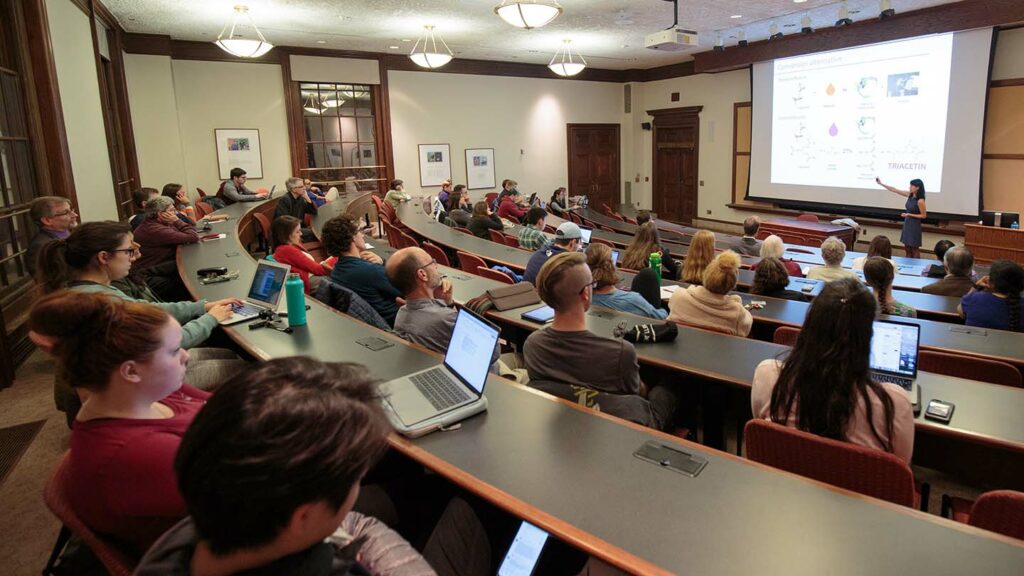How Prof. Lindsay Soh is leading and inspiring next generation of green engineers
By Katie Neitz
Reduce, reuse, and recycle are known as the 3Rs of sustainability. It’s a practice that helps to educate consumers about reducing consumption, reusing as much as possible, and recycling materials that can’t be directly reused—all with the ultimate goal of preventing waste and conserving natural resources.
As an engineer with a background in environmental engineering, Lindsay Soh not only embraces those 3Rs but also adds a fourth R to the practice: redesign.
Soh, associate professor of chemical and biomechanical engineering and Kate and Walter A. Scott ’59 Scholar in Engineering, practices and promotes green engineering in her lab and classroom. Green design uses technology and innovative approaches to investigate and create solutions to environmental problems.
In her recent Jones Faculty Lecture, “Reduce, Reuse, Recycle, Re-design: Engineering for Sustainability,” Soh discussed the importance of green design and how it relates to her particular areas of research, including redesigning biodiesel production processes and greening solvent systems.
Soh was selected by the Office of the Provost to deliver the Jones Faculty Lecture, which was established in 1966 to recognize superior teaching and scholarship at the College. Soh, who recently earned tenure, joined Lafayette in 2013.

She holds a B.S. degree in environmental engineering science from UC Berkeley and a master’s and Ph.D. in chemical and environmental engineering from Yale. At Yale, Soh worked on algal-lipid extraction for the development of biofuel. Part of her dissertation involved investigating carbon dioxide as a green solvent to decrease materials and energy used in the biodiesel process and was awarded a patent related to her work in that area. She has continued that work at Lafayette, incorporating student researchers into her ongoing investigations.
In her lab, Soh teaches and uses principles of green engineering, which means developing solutions that eliminate hazards and minimize pollution, maximizing efficiency, and considering the entire life cycle of a product in order to ensure a holistic approach. Soh used several examples from her own research to demonstrate green engineering.
Biodiesel Production Processes
Soh explained that the United States uses a lot of transportation fuel—more than the rest of the globe—and how there is a need for an alternative. There has been an increase in biodiesel fuel production, but there are some problems: It can be expensive to create and energy-intensive, the fuel can be impacted by cold weather, and the reaction is sensitive to contaminants and creates an undesirable byproduct. This byproduct is glycerol, which is problematic because it is low value and currently has few uses. Soh’s research has looked at these issues with the goal of designing a better alternative.
That work has led her to develop an alternative biodiesel reaction that produces triacetin instead of glycerol. Triacetin is a better byproduct because it mixes well with fuel and can improve some of its properties. It also can be used in cosmetics, flavorings, and pharmaceuticals. There are some issues with triacetin, so the formula can only contain 20%, but it’s still a good alternative.
Greening Solvent Systems
To create biofuels, plants and biomass need to be broken down for processing. This is sometimes done with harsh chemicals that can be expensive and toxic. Soh is investigating the use of green solvents as more economical and environmentally friendly alternatives. One solvent that she has investigated is carbon dioxide.
“This can seem strange to people because carbon dioxide as we know it is gaseous,” she said. “But we can increase the temperature and pressure on carbon dioxide to make it supercritical, which means it changes properties. Supercritical carbon dioxide is inherently safe and can be used instead of more hazardous solvents.”
Soh has found that supercritical carbon dioxide can be as effective at extraction as other more traditional solvents and spoke about its advantages. Furthermore, carbon dioxide can be used to improve reactions. Small changes to the pressure or temperature around the critical point of carbon dioxide can be made to tailor reaction conditions. These changes can decrease the need for downstream processing and lead to improved efficiency.
“The ultimate goal is to develop alternatives that don’t compromise standards in quality or performance,” Soh said. “Innovative solutions are necessary to design a sustainable future.”
